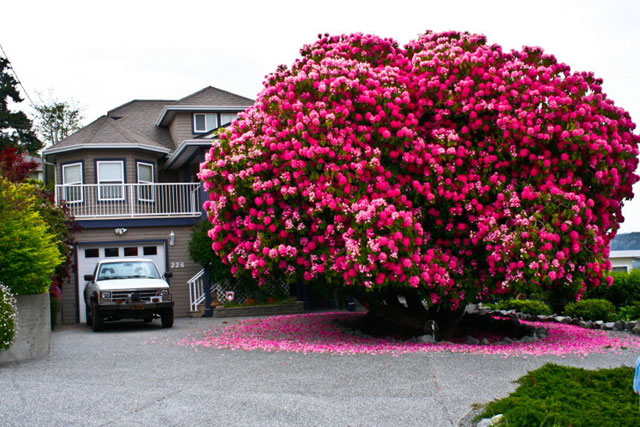2 branches of 100 year-old-plus ‘Lady Cynthia’ collapsed Dec. 20 storm

The Lady Cynthia in Ladysmith B.C. in full bloom in May, 2018. (Jiahong Zhu)
The owner of a stunning plant in Ladysmith B.C. that has gained worldwide attention — and plenty of visitors — hopes it will live on after it was severely damaged in a strong December storm.
Two years ago, the large rhododendron bush, known locally as ‘Lady Cynthia,’ grabbed headlines around the world for its size, age and magnificent show of flowers each spring.
The plant, estimated to be between 115 and 120 years old, is more than nine metres tall, eight metres wide and when in full bloom during a three-week period in May, has more than 4,000 pink blossoms.

The Lady Cynthia in Ladysmith B.C. is a focal point of the town and can be seen from the waterfront. (Jiahong Zhu)
Locals say it can been seen from the town’s waterfront and is a focal point. Many tourists go to see the plant to take pictures and even touch it for good luck.
“It’s a symbol of the city,” said Rob Johnson a historian and city councillor.
‘Hopeful’ it can be saved
On Dec. 20, a major storm blew through the town, knocked out power to residences and businesses and also caused two of the plant’s three main branches to collapse.
 Two of the three stalks of the Lady Cynthia rhododendron in Ladysmith B.C were damaged in the Dec. 20, 2018 storm. (Rob Johnson)
Two of the three stalks of the Lady Cynthia rhododendron in Ladysmith B.C were damaged in the Dec. 20, 2018 storm. (Rob Johnson)
The rhodo sits on the property owned by Peter Richmond, 55, who is the proprietor of a chain of grocery stores in Ladysmith, Chemainus, Duncan and Cedar.
“I mean you could tell it was an old tree but certainly we didn’t expect something like this to happen,” Richmond said.
A single stalk of the plant remains, and Richmond has been told by horticulturalist to have it pruned so it can better handle the weight of the canopy that is left.
“We’ll see what we can do with the piece that’s left . . . it’s kind of tenuous, but we’re all hopeful that we can save that part of it,” he said.

Little Lady Cynthias
Meanwhile, this week, members of rhododendron societies from Nanaimo and Victoria have come to Ladysmith to assess the plant and take cuttings to grow clones of the original plant.
There are two theories about the origins of the plant: one is that is was shipped from the U.K. in the late 1800s or early 1900s; the other is that it is a clone grown from a cutting from a plant in Victoria’s Beacon Hill Park.

Rhododendrons are woody plants native to the Northern Hemisphere with around 1,000 different species. They are grown for the showy spring flowers and foliage in winter.








